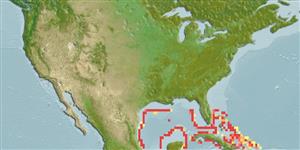Elasmobranchii (sharks and rays) >
Carcharhiniformes (Ground sharks) >
Scyliorhinidae (Cat sharks)
Etymology: Scyliorhinus: Greek, skylla = a kind of shark + Greek, rhinos = nose (Ref. 45335).
Environment / Climate / Range
Ecology
Marine; bathydemersal; depth range 300 - 600 m (Ref. 55584). Deep-water, preferred ?; 28°N - 20°N
Western Central Atlantic: North Carolina south to Florida in the USA and the Santaren Channel between Cuba and Bahamas Bank.
Size / Weight / Age
Maturity: Lm ? range ? - ? cm
Max length : 49.0 cm TL male/unsexed; (Ref. 244)
Found on the continental slope. Maximum length is from an immature specimen. Oviparous (Ref. 50449).
Life cycle and mating behavior
Maturity | Reproduction | Spawning | Eggs | Fecundity | Larvae
Oviparous, paired eggs are laid. Embryos feed solely on yolk (Ref. 50449).
Compagno, L.J.V., 1984. FAO Species Catalogue. Vol. 4. Sharks of the world. An annotated and illustrated catalogue of shark species known to date. Part 2 - Carcharhiniformes. FAO Fish. Synop. 125(4/2):251-655. Rome: FAO. (Ref. 244)
IUCN Red List Status (Ref. 115185)
CITES (Ref. 94142)
Not Evaluated
Threat to humans
Harmless
Human uses
Fisheries: of no interest
More information
Age/Size
Growth
Length-weight
Length-length
Length-frequencies
Morphometrics
Morphology
Larvae
Larval dynamics
Recruitment
Abundance
ReferencesAquacultureAquaculture profileStrainsGeneticsAllele frequenciesHeritabilityDiseasesProcessingMass conversion
Tools
Special reports
Download XML
Internet sources
Estimates of some properties based on models
Phylogenetic diversity index (Ref.
82805): PD
50 = 0.5000 [Uniqueness, from 0.5 = low to 2.0 = high].
Bayesian length-weight: a=0.00324 (0.00157 - 0.00666), b=3.11 (2.93 - 3.29), in cm Total Length, based on LWR estimates for this (Sub)family-body shape (Ref.
93245).
Trophic Level (Ref.
69278): 4.0 ±0.6 se; Based on diet studies.
Resilience (Ref.
69278): Low, minimum population doubling time 4.5 - 14 years (Fec assumed to be <100).
Vulnerability (Ref.
59153): Moderate to high vulnerability (47 of 100) .
